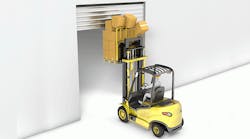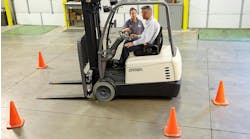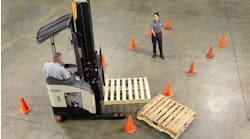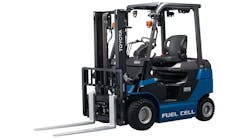Forklift operators have a lot to contend with but safety should still be a top priority. There are production factors such as speed or stress, as well as possible lack of proper tools, attachments and/or accessories. And from time to time, an improper assignment of forklifts and operators can cause confusion. According to the National Safety Council, the average direct cost to a company is $38,000 with $150,000 in indirect costs related to a single forklift incident.
It has been proven that the proper training of forklift operators is a critical element to effective forklift safety. Approximately 42% of forklift fatalities result from the operator being crushed by a tipping vehicle. Many injuries have ensued from not using the seatbelt. According to OSHA and Section 5(a)(1) of the OSHA Act, the General Duty Clause: Operators of powered industrial trucks are obligated to use a restraint or seat belt.
It is interesting to note that an OSHA fine can cost a company up to $7,000 for “minor” infractions, and up to $70,000 for repeat offenders.
Trelleborg Wheel Systems, Toyota Industrial Equipment and The Raymond Corp. are among the sponsors of National Forklift Safety Day founded by the Industrial Truck Association, which will be held June 8-9 at the Hyatt Regency Capitol Hill Hotel in Washington DC. The two-day event enables a platform for the lift truck industry to come together to speak to legislators with the purpose of educating government officials about safety, regulatory and economic issues. Additionally, it reinforces the importance of safety during the operation and maintaining of forklifts by emphasizing OSHA-sponsored training programs, operator certifications, and devising and implementing a safety checklist.
Operator checklists play a vital role in daily forklift use and unfortunately can be easily overlooked. It is helpful to make it a habit with forklift operators just as they would in strapping their seatbelt in their car. Safety can be greatly impacted and equipment compromised when operators cannot be bothered with taking the time to check over even the most basic of forklift components and functionality. It can be as simple as the operator checking tires, the battery, blinkers, horn, steering, braking and travel controls.
From a maintenance perspective, it is helpful to break the checklist down into categories, such as:
Under the Hood: Check the motor oil, power steering, brakes, coolant level, hoses, fuel line leaks belt tensions, fuel level and batteries.
Interior: Check the clutch, steering, horn/safety devices, mirrors, meters and gauges/controls.
Exterior: Check all lights (stop, head, tail, direction, clear/spot/warning), tires, wheels, lug bolts, hydraulic reservoirs, hydraulic lines, steering mechanism, drive line, universal joints, ROPS (rollover protection system), forks, propane tank, coupling devices.
General: Check the exhaust system, engine, fire extinguisher, slow moving triangle and first aid kit.
Properly maintaining forklifts will be addressed as part of National Forklift Safety Day. Industry thought leaders are becoming more proactive with OSHA and implementing their guidance. There are suppliers as well that have taken the steps to exceed progressive tire safety standards and to let operators know when to replace forklift tires.
For instance, Trelleborg Wheel Systems just this year has developed the Pit Stop Line, which enables forklift operators and maintenance personnel to achieve 100% accuracy of tire safety checks through a simple, highly visible orange line that appears as the tire reaches the end of its usability.
Thus far, innovations such as this are securing the ear of politicians, especially in the wake of injuries caused by forklift accidents. OSHA statistics from 2013 report that there are approximately 85 forklift fatalities and 34,900 serious injuries yearly.
Marlee Rosen is a business analyst at Rosen Associates.



